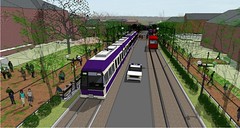 With the D.C. Metrorail’s fares set to increase on Sunday, it piqued my interest in precisely how the system determines charges and the nature of the changes. I decided to take a look at exactly what pattern the famously unpredictable fares took. While most news reports have reported suburban riders would experience the largest absolute increases, my analysis shows they continue to enjoying the lowest cost per mile of all riders, well below the cost of automobile use.
With the D.C. Metrorail’s fares set to increase on Sunday, it piqued my interest in precisely how the system determines charges and the nature of the changes. I decided to take a look at exactly what pattern the famously unpredictable fares took. While most news reports have reported suburban riders would experience the largest absolute increases, my analysis shows they continue to enjoying the lowest cost per mile of all riders, well below the cost of automobile use.
Planning a Fake City
 Our novels, films, and urban planning textbooks are filled with imaginary cities. Whether utopias or dystopias, most of these fictional cities imagine what a city could be at its best — or worst. However, few describe an average city, let alone map out a typical yet entirely fake 1,011 square mile American city in excruciating detail, complete with a named streets and an imaginary history. That’s precisely what my friend Neil Greenberg set out to do with his Fake Omaha project. Read more to find out how he keeps track of 11,000 street names and how imaginary transit systems and mayors transform the fake backwards city into a fake dynamic metropolis, and what we in the real world can learn from it.
Our novels, films, and urban planning textbooks are filled with imaginary cities. Whether utopias or dystopias, most of these fictional cities imagine what a city could be at its best — or worst. However, few describe an average city, let alone map out a typical yet entirely fake 1,011 square mile American city in excruciating detail, complete with a named streets and an imaginary history. That’s precisely what my friend Neil Greenberg set out to do with his Fake Omaha project. Read more to find out how he keeps track of 11,000 street names and how imaginary transit systems and mayors transform the fake backwards city into a fake dynamic metropolis, and what we in the real world can learn from it.
Counting Metro’s Riders
Debating Purple in College Park
 Where should a proposed rail link between Metro’s suburban Maryland spokes cross the University of Maryland campus? A debate between top administrators and students is brewing on campus about whether the Purple Line should stop at the student union or a quarter of a mile to the north. At issue: the meaning of the campus master plan, pedestrian safety, and perhaps an antiquated “aggie” mentality that placed the College Park Metro station over a mile from campus.
Where should a proposed rail link between Metro’s suburban Maryland spokes cross the University of Maryland campus? A debate between top administrators and students is brewing on campus about whether the Purple Line should stop at the student union or a quarter of a mile to the north. At issue: the meaning of the campus master plan, pedestrian safety, and perhaps an antiquated “aggie” mentality that placed the College Park Metro station over a mile from campus.
Washington’s Urban Facelift
Research Help
I am doing some research and hope some readers here can help. I’m looking for: Examples of low to moderate density residential neighborhoods connected by a street grid to moderate density retail or mixed use districts. Neighborhoods near busy roads and with high income levels would be a plus. Example track cross sections and other […]
Information Design and Public Transit
The Washington, D.C. public has an aversion to public buses, particularly Metrobus operated by the Washington Metropolitan Transit Authority. Does the region have an inherent bias against buses? A few bus routes are extremely well used in both high and low income neighborhoods (the 30s accomplishes this in one line). Furthermore, the DC Circulator, Georgetown […]

